HOME www.tegels-uit-rotterdam.com
Tiles from the Piet Hein Workshop of F J Kleyn in Delfshaven in the Royal Scottish Museum, Edinburgh
In 1989 Hans van Lemmen visited the Royal Scottish Museum to inspect the reserve collection of tiles in preparation for the Edinburgh TACS visit in September of that year. He noticed a set of Dutch tiles donated by F J. Kleyn in 1861 made at the Piet Hein tile factory in Delfshaven, Holland. Realizing their significance he photogrciphed all the tiles and sent copies to Wilhelm Joliet, a German expert on Dutch tiles made in Rotterdam, who has subsequently written this article for Glazed Expressions. This is the first time anything has appeared in print about the little known Piet Hein tile factory and the man who owned it. (Piet Hein was a Dutch admiral born in Delfshaven in 1578. He became famous for beating the Spanish on several occasions, and was killed in battle in 1629.)
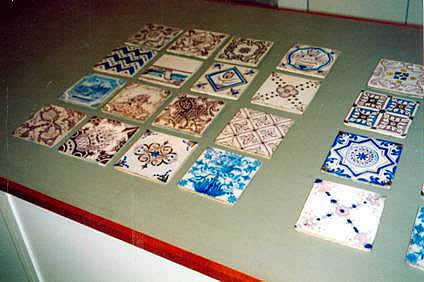

In 1861 F J Kleyn of Delfshaven, near Rotterdam, donated 42 tiles to the Royal Scottish Museum (then called the Industrial Museum of Scotland) in Edinburgh. Each tile bears on the reverse a paper sticker with the following inscription:
Industrial Museum of Scotland
719.46
Dutch Mural Tile
Presented by Mr F J Kleyn
Oct 1861 Delftshaven
They are clearly tiles which had not previously been used. Some are slightly damaged due to storage.
A comparison of the tiles in the museum at Edinburgh with the socalled Rotterdam Pattern Book shows that 17 of the 39 designs are the same. A comparison with the pattern books of other Dutch tileries shows that many designs were manufactured in a wide variety of areas and workshops. Time and time again tiles are attributed far too rashly to particular areas of the Netherlands, to certain periods or even definite workshops without adequate proof being given.
The tiles presented to the museum in Edinburgh are cautionary evidence of the difficulties of identification and dating. The tiles are especially important from a cultural-historical point of view for they show us that, in the Piet Hein workshop of F J Kleyn in Delfshaven in the second half of the 19th Century, tiles were being decorated with anything from early-18th Century styles to what were then contemporary designs.
This mixture of the very old and new designs can also be found in the Rotterdam Pattern Book (this book with tile designs was given to the Rotterdam City Archive in 1876 by the very same F J Kleyn who is the subject of this article). Although the Rotterdam City Archive donation records call it Model boekje van het Tegelbakkers Gilde te Rottm. (Pattern book of the Tilemakers Guild in Rotterdam), it can be assumed that the compilation under consideration was put together by F J Kleyn and that this book was used by him for showing individual tile designs to his customers.
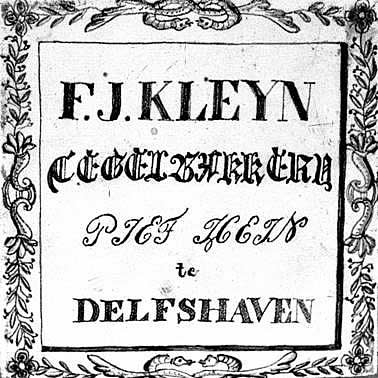
Trade tile that states the following: F J Kleyn Tegelbakkerij Piet Hein te Delfshaven (F J Kleyn Tile Factory Piet Hein in Delfshaven)
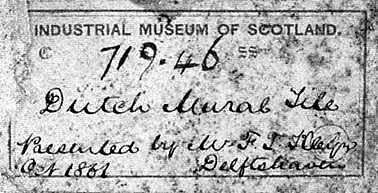
Label on the back of one of the F J Kleyn tiles in the Royal Scottish Museum, Edinburgh
Frederik Jacobus Kleyn was born in Rotterdam on 19 October 1819. His parents were Antonie Kleyn and Anna Maria Elisabet Eilerkamp. At the time of the 1829 census the former (Antonie Kleyn) lived with his wife and four children, of whom Frederik Jacobus was the eldest, in Rotterdam in a house on the Vest nr. 364. Antonie Kleyn was a self-employed coachman.
On F J Kleyn's marriage certificate he is called a 'carrier'. He was working in the office of Aalmis Verwijk & Sons in 1842 and lived there with his mother. In 1843 he and his mother were accommodated at the rear of a house on Schiedarnsche Dijk 291, the home of the De Bloempot tile workshop which was in the hands of the new owner Van Traa.
On 19 February 1845 FJ Kleyn married Catharina Maria Theresia Hopman who was a descendant of Jan Aalmis. Kleyn left Van Traa's employment in 1850. His last salary was paid on 21 August 1850. On l January 1851 he was living in Delfshaven at Schoonderloo 71. His occupation was given as 'manufacturer'. He put the experience he had gained at the tile workshop De Bloempot to use and registered a tile workshop of his own. On 31 December 1859 he was registered as a tile manufacturer and lived at Schoonderloo E 68K (later D102) in Delfshaven.
Kleyn moved to Vrijenban on 16 April 1869. In 1872 he returned to Delfshaven. In 1873 his Description and History of De1fshaven was published by Joh. L van der Pauwert. In 1874 he moved to Rotterdam where in 1876 he donated his tile pattern book to the city. He died there on 30 January 1898 at the age of 78.
Until now no research reports on the history of the Piet Hein faience workshop have been published. As we already know, in 1850 FJ Kleyn had left the services of the Rotterdam tile factory Van Traa to set up his own firm in Delfshaven in 1851. It has emerged from archive documents that the tile factory Piet Hein existed in Delfshaven from 1851 to 1866. It is intimated in the General Delfshaven Annual of 1861 that the workshops and factories were suffering from lack of sales. Tensions in Europe and the Civil War in America were stated as the causes. It was recommended by the Chambers of Cooperative Trade and Factories in 1861 to take up or intensify trade abroad, above all with England and Belgium. It was explicitly noted in the 1861 annual: De Tegelbakkerij heeft door weinig aflevering naar buiten's lands minder verwerkt (The tile factory has produced less because of fewer exports abroad).

Tile from the F J Kleyn workshop with a mythological scene depicting the Rape of Europa. The Greek god Zeus in the guise of a bull carries her across the Bosperus.
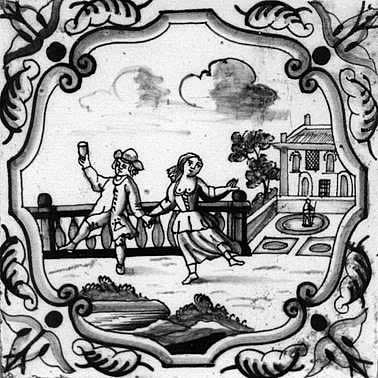
Tile from the F J Kleyn workshop with two figures dancing in the garden of a country house. This kind of scene is also found on 18th century tiles made in Rotterdam.
In 1861 the Piet Hein tile factory employed seven workers. The last Rotterdam tile factory of Van Traa had already closed its doors in 1854 under pressure from foreign products and, above all, the up-and-coming mechanization of production processes (e.g. England). The introduction of mechanical production processes to tile manufacture could offer no alternative to Kleyn as all the raw materials and fuel for the firing of the tiles would have to be brought into Delfshaven. Kleyn followed the administration's recommendation and tried to set in motion and intensify his exporting activity (including to Britain).
We must now pose the question, What could have been the reasons for the donation of the tiles to Edinburgh in 1861? If the Royal Scottish Museum is a museum in the present sense of the word, one must regard its predecessor, the Industrial Museum of Scotland, in a different light. It was founded in Edinburgh in 1855 as a typical museum of the 19th Century. Industrialization had brought machinemade wares for the masses on to the market, Handcraft skills found it hard to stand their ground against cheaper factory offerings. Trade societies tried to promote arts and crafts and 'improve' the taste of the masses through displays of examples of craft-produced wares. World exhibitions - first in London in 1851 - gave comprehensive overviews of contemporary creativity in art, arts and crafts, hand-made ware and industry.

Tile from the F J Kleyn workshop with a river scene and finely painted cherub corners.
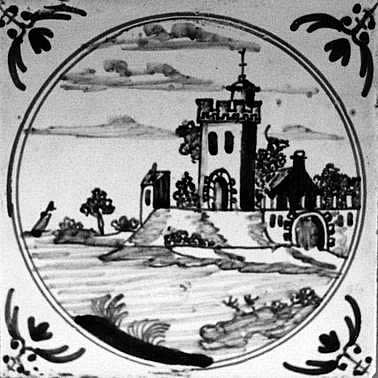
Tile from the F J Kleyn workshop showing a castle on the back of a river with ox-head corner motifs.
The foundation of museums such as the South Kensington Museum in London in 1852 showed the way towards systematic collecting and influence on the so-called 'good taste' of the population. Here is part of what Dr Justus Brinckmann in 1866 in a cry for the foundation of a museum of art and industry in Hamburg: '...the time has come to establish a museum with the aim of promoting the people's insight into the historical developments of the art industry, influencing and refining the direction of their taste.'
In this light the reasons for the donation and acceptance of the tiles could be: (a) the attempt of F J Kleyn to sell hand-made tin-glazed tiles in Britain; (b) to display hand-made tiles from the Netherlands as an insight into the historical course of development of glazed and decorated earthenware tile production. Unfortunately the tiles described are in the reserve collection of the Royal Scottish Museum. It is hoped that they will be moved into the limelight very soon and take up the position which, in the opinion of the author, they deserve.
Notes
1 The Information on Kleyn is taken from Rotterdam City Archive data as well as particulars printed by Hoynck van Papendrecht and E Wiersum.
2 FJ Kleyn participated fully in the life of the city. He was, amongst other things, a member of the commission set up to erect a statue in honour of the mariner hero Piet Hein. It was unveiled on 17 October 1870 in Delfshaven. The names of the technical commissioners, including FJ Kleyn as Secretary to the Commission, are on its base.
3 A frequent change of spelling occurs in the name Kleyn/Kleijn and Piet Heijn/Pjet Hejn/Hein in documents consulted.
With the permission of Mr. Hans van Lemmen and the Tiles & Architectural Ceramics Society
www.tilesoc.org.uk
ROYAL MUSEUM OF SCOTLAND,
CHAMBERS STREET, EDINBURGH EH1 1JF
www.nms.ac.uk